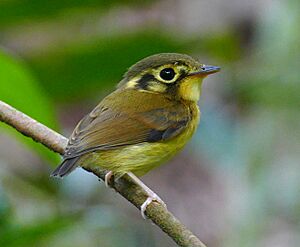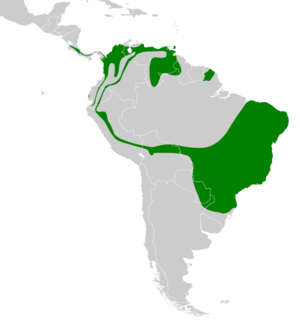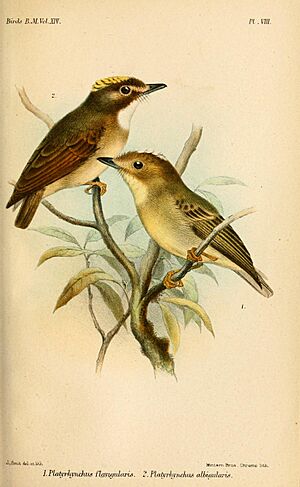White-throated spadebill facts for kids
Quick facts for kids White-throated spadebill |
|
|---|---|
 |
|
| Conservation status | |
| Scientific classification | |
| Genus: |
Platyrinchus
|
| Species: |
mystaceus
|
 |
|
| Synonyms | |
|
|
The white-throated spadebill (Platyrinchus mystaceus) is a very small bird. It belongs to the tyrant flycatcher family. These birds live in the warm, tropical parts of the Americas.
Contents
What Does a White-throated Spadebill Look Like?
Adult white-throated spadebills are about 9.7 cm (3.8 inches) long. They weigh around 9.4 grams (0.33 ounces). These tiny birds have big eyes and a very short tail.
Their heads have special markings. They have a long yellowish stripe above their eyes. Their cheeks are dark, and they have a yellow ring around their eyes. A black stripe runs down each side of their neck.
Cool Features of the Spadebill
The top of their head has a hidden yellow crest. When a male bird sings, he can raise this crest like a fan! Their upper body is dark olive-brown. Their belly is a light buff color, but their throat is white.
Their beak is black on top and brown underneath. It is very wide and flat. This wide beak is why they are called "spadebills." The scientific name Platyrinchus also means "flat beak."
Differences Between Male, Female, and Young Birds
Male and female spadebills look quite similar. However, female birds have a smaller crest on their heads. Young spadebills are brighter and more reddish. They do not have the crest. Their throat and chest are grey, fading to a whitish belly.
These birds do not sing loudly very often. They make a sharp chweet sound.
Different Types of White-throated Spadebills
There are different types, or subspecies, of the white-throated spadebill. One type, Platyrinchus mystaceus insularis, lives only in Trinidad, Tobago, and Venezuela. Other types might have slightly different colors on their belly or crest. Scientists are still studying these birds to understand them better.
Where Do White-throated Spadebills Live?
The white-throated spadebill lives in many places. They are found from Costa Rica all the way through South America. You can see them in western Ecuador, Brazil, and northeastern Argentina. They also live on the islands of Trinidad and Tobago.
These birds are quite common in their wide home range. Because there are so many of them, they are not considered an endangered species.
Their Favorite Homes
White-throated spadebills like to live in wet forests on hills. They can also live in forests that have been disturbed by humans. They prefer places with thick, tangled plants close to the ground. They also like medium-sized trees with a leafy top, called a canopy. These trees are often covered with other plants like epiphytes.
What Do White-throated Spadebills Eat?
White-throated spadebills are active birds that usually live alone. They can be hard to spot because they move quickly through the plants. They are always looking for small arthropods, like insects and spiders. These tiny creatures are their main food.
They catch their food in a special way. They quickly fly upwards from under leaves. They snap their beak shut with a loud sound to catch the insect. Sometimes, they catch insects right out of the air. These birds sometimes join groups of different bird species that are all looking for food together.
Life Cycle and Reproduction
The white-throated spadebill builds a deep, cup-shaped nest. They make it from dead grass and plant fibers. The nest is usually placed low down in a young tree.
A female spadebill usually lays two eggs. The eggs are white with a yellowish tint. They also have a reddish-brown ring pattern on them.



